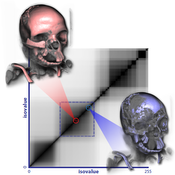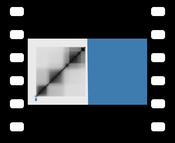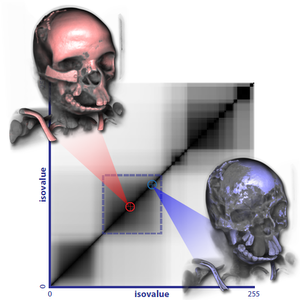Information
- Publication Type: Journal Paper with Conference Talk
- Workgroup(s)/Project(s):
- Date: June 2010
- Journal: Computer Graphics Forum
- Volume: 29
- Number: 3
- Note: EuroVis 2010 Best Paper Award
- Location: Bordeaux, France
- Lecturer: Stefan Bruckner
- Event: EuroVis 2010
- Conference date: 9. June 2010 – 11. June 2010
- Pages: 773 – 782
- Keywords: isosurfaces, volume visualization, mutual information, histograms
Abstract
In this paper, we introduce the concept of isosurface similarity maps for the visualization of volume data. Isosurface similarity maps present structural information of a volume data set by depicting similarities between individual isosurfaces quantified by a robust information-theoretic measure. Unlike conventional histograms, they are not based on the frequency of isovalues and/or derivatives and therefore provide complementary information. We demonstrate that this new representation can be used to guide transfer function design and visualization parameter specification. Furthermore, we use isosurface similarity to develop an automatic parameter-free method for identifying representative isovalues. Using real-world data sets, we show that isosurface similarity maps can be a useful addition to conventional classification techniques.Additional Files and Images
Additional images and videos
 Image:
Isosurface similarity map with two isovalues highlighted
Image:
Isosurface similarity map with two isovalues highlighted
 Video 1:
Interactive demonstration
Video 1:
Interactive demonstration
 Video 2:
Similarity-Enhanced Isosurface Visualization
Video 2:
Similarity-Enhanced Isosurface Visualization
 Video 3:
Similarity-Based Isovalue Remapping. Left (blue): Conventional linear mapping. Right (red): Similarity-based mapping.
Video 3:
Similarity-Based Isovalue Remapping. Left (blue): Conventional linear mapping. Right (red): Similarity-based mapping.
Additional files
Weblinks
BibTeX
@article{bruckner-2010-ISM,
title = "Isosurface Similarity Maps",
author = "Stefan Bruckner and Torsten M\"{o}ller",
year = "2010",
abstract = "In this paper, we introduce the concept of isosurface
similarity maps for the visualization of volume data.
Isosurface similarity maps present structural information of
a volume data set by depicting similarities between
individual isosurfaces quantified by a robust
information-theoretic measure. Unlike conventional
histograms, they are not based on the frequency of isovalues
and/or derivatives and therefore provide complementary
information. We demonstrate that this new representation can
be used to guide transfer function design and visualization
parameter specification. Furthermore, we use isosurface
similarity to develop an automatic parameter-free method for
identifying representative isovalues. Using real-world data
sets, we show that isosurface similarity maps can be a
useful addition to conventional classification techniques.",
month = jun,
journal = "Computer Graphics Forum",
volume = "29",
number = "3",
note = "EuroVis 2010 Best Paper Award",
pages = "773--782",
keywords = "isosurfaces, volume visualization, mutual information,
histograms",
URL = "https://www.cg.tuwien.ac.at/research/publications/2010/bruckner-2010-ISM/",
}


 Paper
Paper